Richard Ellenbogen recently gave an important presentation on New York State’s Energy Transition that details his concerns with the net -zero mandate of the Climate Leadership and Community Protection Act (CLCPA). I think it is important that his message gets out to all New Yorkers.
Unfortunately, the presentation is very detailed to avoid issues with those people who have a monetary interest in this process and the climate zealots who will undoubtedly disagree with the findings and recommendations. This makes the video over two hours long and very dense. This is beyond the attention span of most people. I tried to address that problem by highlighting what I think are the primary points with links to the corresponding sections of the video.
Ellenbogen is the President [BIO] Allied Converters and frequently copies me on emails that address various issues associated with the CLCPA. I have published other articles by him and a description of his keynote address to the Business Council of New York 2023 Renewable Energy Conference Energy titled: “Energy on Demand as the Life Blood of Business and Entrepreneurship in the State -video here: Why NY State Must Rethink Its Energy Plan and Ten Suggestions to Help Fix the Problems.” There are only a few people in New York that are trying to educate people about the risks of the CLCPA with as much passion as I am but Richard certainly fits that description. He comes at the problem as an engineer who truly cares about the environment and how best to improve the environment without unintended consequences. He has spent an enormous amount of time honing his presentation summarizing the problems he sees but most of all the environmental performance record of his business shows that he is walking the walk.
CLCPA Overview
The CLCPA established a New York “Net Zero” target (85% reduction and 15% offset of emissions) by 2050. It includes an interim 2030 reduction target of a 40% reduction by 2030 and a requirement that all electricity generated be “zero-emissions” by 2040. The Climate Action Council (CAC) is responsible for preparing the Scoping Plan that outlines how to “achieve the State’s bold clean energy and climate agenda.” In brief, that plan is to electrify everything possible using zero-emissions electricity. The Integration Analysis prepared by the New York State Energy Research and Development Authority (NYSERDA) and its consultants quantifies the impact of the electrification strategies. That material was used to develop the Draft Scoping Plan. After a year-long review, the Scoping Plan recommendations were finalized at the end of 2022. In 2023 the Scoping Plan recommendations are supposed to be implemented through regulation and legislation. Ellenbogen’s presentation focuses on these proposed implementation programs.
Presentation Introduction
The Introduction to the presentation explains:
The following video has been made as a public service for the citizens of New York State. The speakers have no monetary interest in the fossil fuel industry or in any of the equipment manufacturers related to the energy transition. The rental of the Pelham Picture House, used for the presentation, was covered at their personal expense.
Ellenbogen sent me an email that described the presentation. He wrote:
The video has some major differences from the presentation that was done as the keynote presentation at the Business Council of NY State Renewable Energy Conference as recent events have made it more apparent that the NY State Energy plan has major flaws in its logic. Those issues were not unexpected, however watching them occur in real time has made addressing the problems an imperative. Things are not going to get better.
There are several parts of the presentation. Two videos were running prior to the presentation while people were entering the theater. One is a video describing the products his company makes and how his facility has been made more energy efficient. The second video explains sustainability at Allied Converters and how it has kept them in business despite New York’s high energy prices. The presentation video itself includes an 8-minute introduction that that used these slides. The rest of the video is an 80-minute presentation (slide deck) followed by 45 minutes of questions and answers.
Ellenbogen notes:
The presentation is long because it is very detailed. It was done that way because everyone that has a monetary interest in this process, along with the climate zealots, is going to try and disparage the information contained in the presentation so I tried to cover all of the issues to avoid that as much as possible.
I am very aware of problems related to trying to describe the intricacies and problems with the CLCPA transition. It is related to one of my pragmatic environmentalist principles namely the BS Asymmetry Principle described by Alberto Brandolini: “The amount of energy necessary to refute BS is an order of magnitude bigger than to produce it.” Richard and I must delve into the details to respond to the flaws of the CLCPA. This is necessary but it also makes it difficult for people to handle the amount and complexity of information needed to explain flaws. I tried to highlight what I think are the key points in the presentation with links to the corresponding section of the video in case readers do not have the time to listen to the whole thing.
Key Points
In the Introduction Ellenbogen presents an overview of the CLCPA and some of the problems. A recurring theme in the presentation is that other jurisdictions, especially Germany. that have been trying to do the same thing as planned in the CLCPA are not doing so well. Ignoring their experience is risky. He argues that the CLCPA is a fantasy for the following reasons:
- Lack of energy to support the plan,
- The renewables needed cannot be installed on the mandated schedule,
- Costs to excecute the plan will be much greater than other emission reduction strategies,
- The plan will increase GHG emissions more than other strategies, and
- There are logic errors in the analyses.
John Ravitz from the Business Council of Westchester County collaborated with Ellenbogen to organize the presentation. During his introduction he argued that we all want a better environment, but we have to do it the right way. He emphasized the need to have honest conversations about how to get there. I agree with all those points. He also said something that confirmed what I had long suspected. He pointed out that the CLCPA legislation was passed “in the dead of night” at the end of the session and “I guarantee you that 99.9% of the members of the New York State Legislature did not read the bill.” He said they did not understand the schedule issues and unintended consequences that could happen.
The presentation itself starts with more background of what Ellenbogen did at his business and how that background worries him about the proposed plan to meet the CLCPA mandates.
There are only two issues where I have substantially different opinions than Ellenbogen. While I can agree that reducing emissions is a good thing I do not believe that greenhouse gas emission reductions will have any effect on extreme weather. I toyed with including a more detailed argument for my belief and a response to Ellenbogen’s comments in this regard but I do not want to detract from the main point that the CLCPA is bad policy.
My concerns about the implementation of the CLCPA are very similar to Ellenbogen, but we are not exactly aligned. One of his big departures from the narrative of the CLCPA acolytes is that he sees a place for new natural gas combined cycle turbines. That is heresy to those who insist on zero emissions. I agree with Rich on that, but I think the use of existing fossil-fired generating units is appropriate too because many units have installed additional controls, have lower emissions than in the past, and still fulfill critical reliability services. There is no question that until the New York independent System Operator (NYOSO) determines those units can be shut down they have to remain available. However, I believe that it may be appropriate to keep some of those units on standby longer than anyone else admits at this point because wind and solar resources availability during worst-case conditions is a much bigger problem than most people realize. Those old units can be an insurance policy for those rare and relatively short-term events.
His description of the Complex Problem Conundrum is particularly important. In the rush to reach zero the Climate Act does not account for likely ratepayer reactions. If you force people to use something that is more expensive and does not work as well they may resort to alternatives that are even worse.

Another important discussion explains why New York State energy policy is a mess. He argues and I agree that political interference in the technical issues associated with operating a reliable and affordable electric energy system cannot end well. It cannot be emphasized enough that a realistic cost/benefit analysis has not been done. The Hochul Administration has never provided detailed documentation for the costs and expected emission reductions for the specific control strategies that are included in the Scoping Plan. That should be the first component of an honest conversation. His discussion goes on to list many of the obstacles to implementation that are also prime topics for conversations.
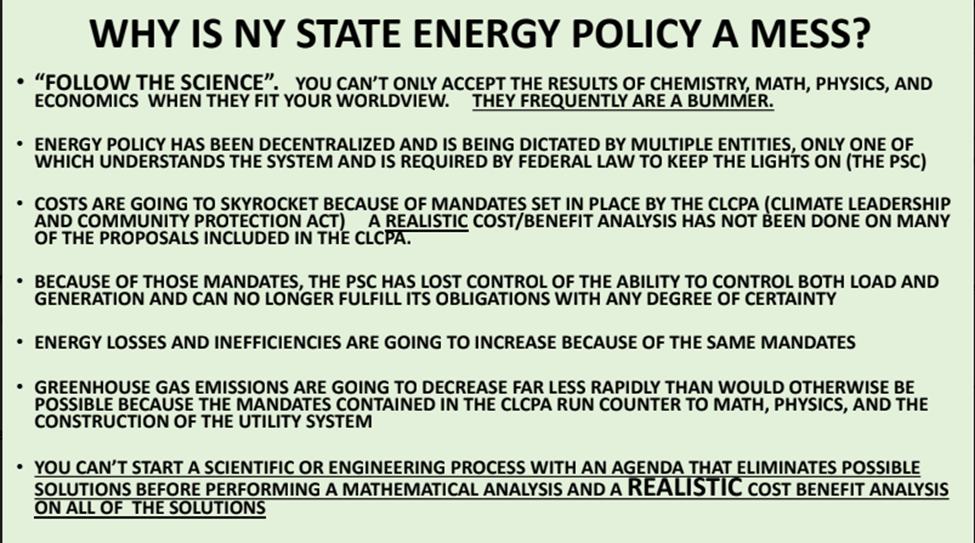
I agree with Ellenbogen’s description of obstacles that must be overcome. He points out that we are not learning from others and that “Insanity is doing the same thing over and over and expecting different results.”
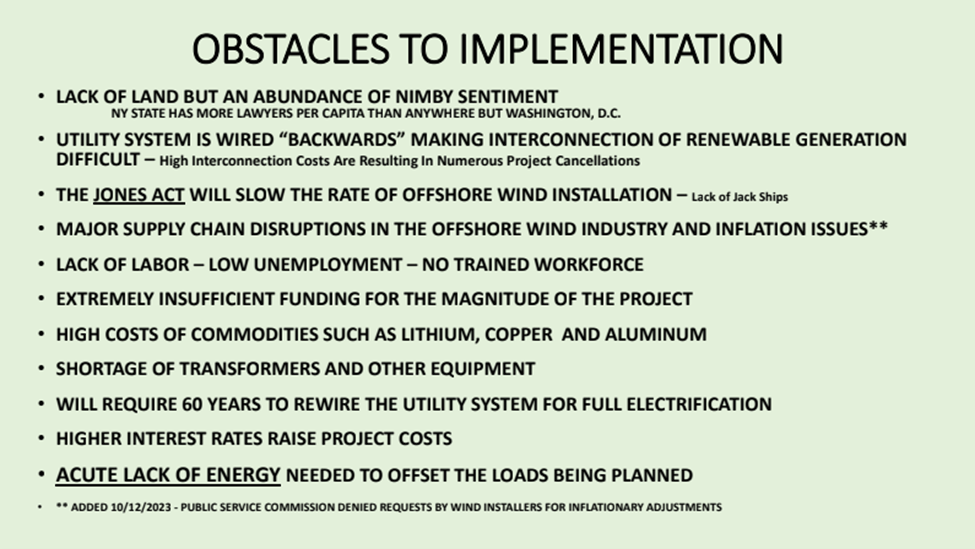
I have written about the statement by Robert W. Howarth, Ph.D., the David R. Atkinson Professor of Ecology & Environmental Biology supporting the adoption of the Scoping Plan. Howarth claims to be an author of the CLCPA and was a member of the Climate Action Council. Ellenbogen addresses the academic article that Howarth co-authored that is the basis of the Climate Act presumption that no new technology is needed for the electric system transition and that the mandated schedule is possible. Because he is a graduate of Cornell, Ellenbogen felt it was necessary to explain his reasoning in his email:
To anyone at Cornell or Stanford that has a problem with the presentation at the 47 minute mark, I stand behind what I said. There is information in those documents that was false in 2013 and that has been proven by the fact that in 2023, the technologies that they claimed were readily available then still don’t exist in a form that can be used on the utility system, but this document is being used as the basis for NY State Energy policy and people may die as a result.
Later in the presentation he references work by Cornell engineers that says the transition plan that is the basis of the CLCPA will fail. It is really troubling that Ellenbogen and the power system experts at Cornell have not been able to influence New York energy policy away from the mis-guided and refuted academic paper co-authored by a biologist.
The CLCPA will affect the way we heat our homes. Ellenbogen has personal experience with heat pumps and does a good job explaining why the focus on heat pumps as a solution by NYSERDA will fail. He points out problems that have been observed in Germany in the following slide.
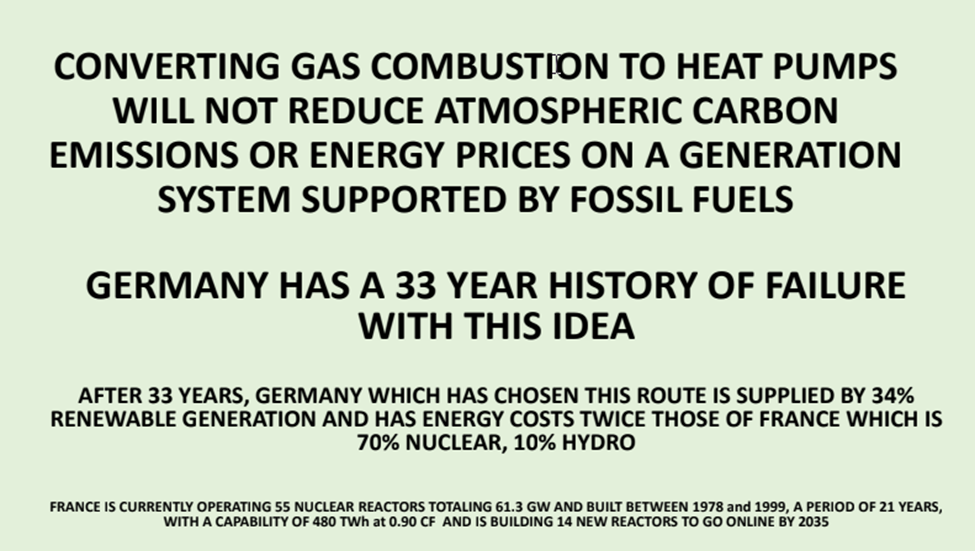
The CLCPA will also affect the way we cook. The usual suspects have been vilifying natural gas stoves and the presentation addresses this component of the net-zero transition. He argues that the health impact claims are not worth the paper they are printed on and the tradeoff between benefits and costs is poor.
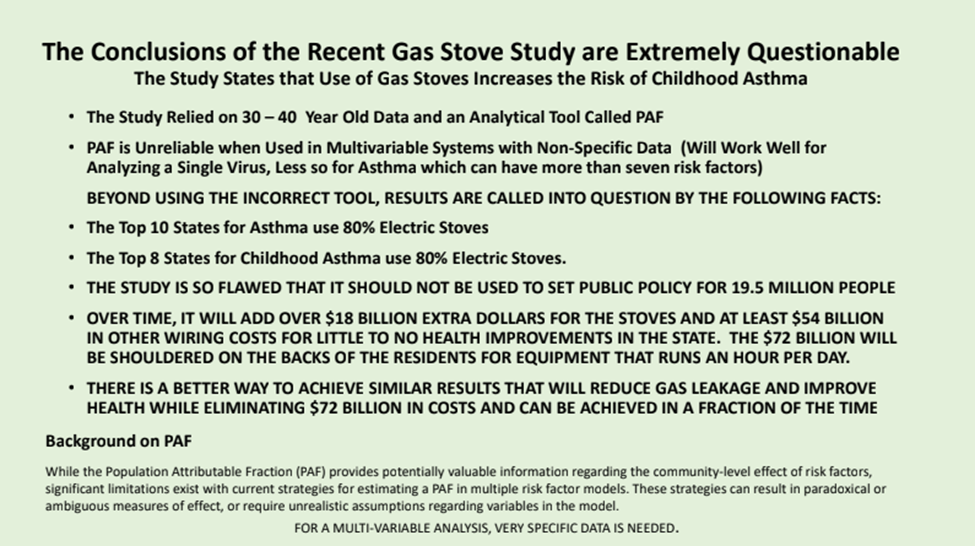
In order to explain why the Integration Analysis is fantasy he provides background information on the difference between power and energy and why capacity factors are important. Ellenbogen repeatedly states that “I am not anti-renewable but you have to look at the numbers and be realistic”. The power, energy, and capacity factor numbers affect the viability of a renewable energy powered electric grid.
He describes the analysis in the Scoping Plan for the CLCPA as fantasy. The Power, energy, and capacity factor estimates in the Integration analysis are not realistic. I love the description of the 20 GW of zero-carbon firm resource as “unicorn generation” because “you are as likely to see it as you are to see a unicorn.” Everyone except Howarth and his acolytes believes that this zero-carbon firm resource is needed to address infrequent periods of extended low wind and solar resource availability. The energy transition requires this new technology, but the State has unrealistic expectations for implementing it.
Ellenbogen’s presentation presents a rational alternative to the fantasies of the CLCPA implementation plan. He looks at the electrical load necessary to replace the energy used for applications other than electric generation – heating, cooking, hot water, and transportation and concludes that on-site combustion of natural gas should have a role. The Cornell study of energy storage shows a much higher estimate of amount needed and that increases costs significantly.
For the cost of the storage needed you could build 6 or 7 nuclear plants that would produce dispatchable power and would last 60 years. Wind and solar life expectancy is on the order of 20 years and batteries half of that which makes this transition strategy is much more expensive. He notes that implementation costs are already starting to show up in rate cases and this will only continue. His arguments for alternatives also point out that batteries will increase emissions until all the generation is zero-emissions.
Ellenbogen has refined his analysis over time. I think his arguments to leave on-site combustion in place are particularly persuasive. It is more efficient to use on-site generation. He advocates for increased use of electric vehicles and allowing this generation frees up energy for them which means less generation is required. He also recommends a pragmatic approach to reduce CO2 emissions from utility-scale co-generation. The productivity in greenhouses increases substantially at higher CO2 levels and the CO2 is taken up by the plants. I vaguely recall a plan to build greenhouses at the industrial park where the Micron chip fabrication plant is planned. Using a co-generation power plant to provide the electricity needed by that facility, using the waste heat for fabrication processes, and supplying the CO2 to the greenhouses addresses multiple problems and reduces overall costs.
Finally, he makes recommendations to reduce personal utility costs and short- and long-term changes to the New York energy plan. It is no surprise that energy efficiency is important for personal utility cost reductions. For the energy plan he suggests the following short-term recommendations:
- Do not electrify buildings that run on natural gas,
- Focus heat pump deployment away from buildings that run on natural gas,
- Upgrade the grid infrastructure to support the electrification requirements,
- Increase support for electric vehicle infrastructure including grid support,
- Do not install large amounts of battery storage until renewable generation increases,
- Repower older generating plants with higher efficiency combined cycle natural gas units,
- Develop technologies other than electrolysis to generate green hydrogen,
- Focus natural gas resources on combined heat and power systems,
- Allow Micron to build a 2 GW combined cycle co-generation facility,
- Figure out how the utilities can install and interconnect the planned offshore wind,
- Set up pilot projects for greenhouse agriculture to ascertain values, and
- Authorize the establishment of pyrolysis projects for the elimination of plastic waste and organic waste and for generation of hydrogen that can be used to improve power plant efficiency.
In the long term he suggests adding 12 GW of nuclear to the generating system.
He concludes that New York should use common sense solutions to keep the lights on because when fantasies meet reality, reality always wins. He notes that the CLCPA actually is hindering greenhouse gas emission efforts, risks reliability and will affect affordability. In the following slide he urges people to contact their State Senators and Assemblypersons to modify or repeal the CLCPA.
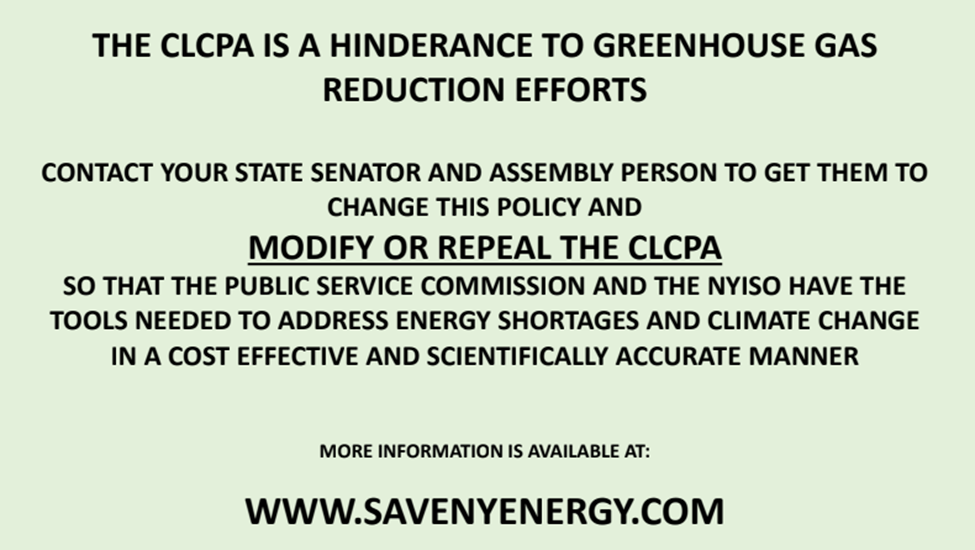
Q&A
If you are interested in the questions and answers they start at this point. The session got heated when someone who subscribes to all of the CLCPA narrative talking points that Ellenbogen dismantled in his presentation asked why wind and solar alone can’t work and claimed nuclear has no place. It got so bad that someone in the audience piped in and said if you cannot provide numbers supporting your position like Ellenbogen did then sit down because you wasting our time.
Caveat
Ellenbogen has invested enormous time and energy into this presentation because of his personal conviction that the current plan is not a good idea. He writes:
Keep in mind that I have no monetary interest in this but I have a huge problem with the questionable or deceptive at best, and negligent at worst, science being used to justify these policies. I have spent thousands of hours researching the details and have attended all of the meetings in Albany and elsewhere at my personal expense, both in time and money, as well as paying for the rental of the Picture House, along with John Ravitz.
Conclusion
Ellenbogen points out that the societal benefits are calculated as if New York is in a vacuum. The fact is that completely eliminating New York greenhouse gas emissions will not have a meaningful effect on any of the impacts ascribed to climate change because the state’s total emissions are so small that they will be subsumed by emission increase elsewhere across the globe in a matter of weeks. He goes to great lengths so point out that he is not anti-renewable energy resources. These points and others that disparage the CLCPA transition plan do not mean that we should not do something to reduce GHG emissions. However, we should not “make up fantasies to justify it” or avoid honest conversations about how best to implement a transition to lower emissions. It is time to honestly talk about the implications of this law.
Ellenbogen has the ear of many people at the agencies in Albany and unofficially they agree with his concerns. Unfortunately, they are not in the position to say anything publicly because the CLCPA is a law and the agencies have been weaponized to support the political ambitions of the Administration in the last decade. Speaking out of line with narrative is not a good career move for technical staff at the agencies. Privately they admit that it will take a Texas-style blackout disaster to change the direction of the net-zero transition. The February 2021 Texas electric grid failure was the worst energy infrastructure failure in Texas history resulting in over 4.5 million homes and residences losing power in very cold weather, over 245 people dying and total damages of at least $195 billion.
Remember that New York energy experts are warning that unless something is done this type of disaster is inevitable here. I prepared this summary of the presentation because I think it is important to educate New Yorkers. I reiterate Ellenbogen’s recommendation: contact your State Senators and Assemblypersons to modify or repeal the CLCPA. Contact the Governor’s Office so that the Administration gets the word that the loud environmental organizations are not the only ones concerned about this law. Pass on this presentation to others who will be affected by this fantastical energy policy and encourage them to speak up. It is too risky, we cannot afford it, and the plans are unsupportable.

7 thoughts on “Ellenbogen: New York State’s Energy Transition”